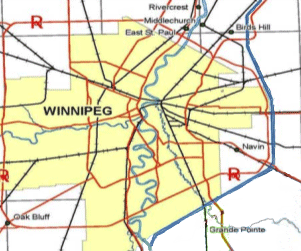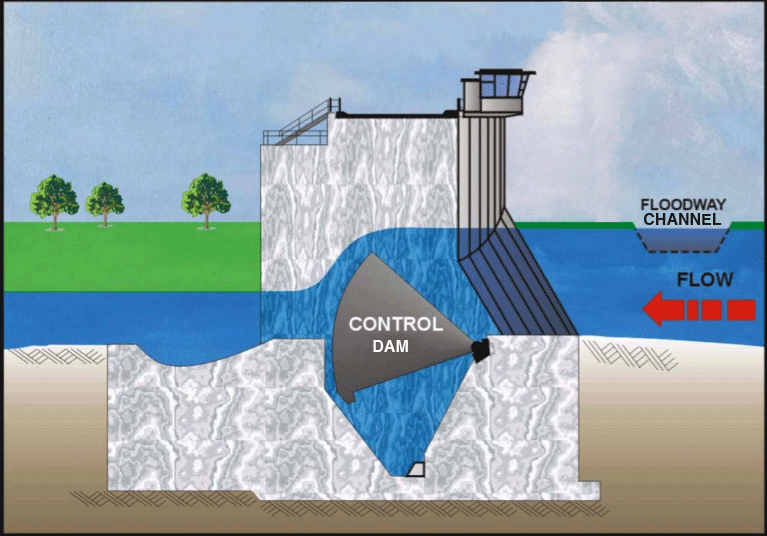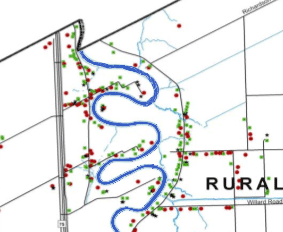The Red River floodway consists of a channel around the city of Winnipeg, and an adjustable dam on the river.

(The diagrams used here are based on diagrams in the Artifical Flooding in the R.M. of Ritchot Public Information Sessions,
http://www.floodwayauthority.mb.ca/pdf/ritchot_open_house.pdf, held by the MMM Group in October, 2008.)
The floodway is operated by raising the dam. When the dam is raised, the water in the river backs up, and fills a reservoir.
When the water gets deep enough, water starts to flow into the floodway channel.

There are no gates to open !
For 40 years people have talked about “opening the gates to the floodway”, have demanded that the gates be opened
to relieve high water levels. But there are no gates, the floodway works by damming the river.
The reservoir is the Rural Municipality of Ritchot, home to about 5000 people.
Much land there is covered with water as a result of floodway operation.
It takes very deep water in the reservoir to obtain significant flows in the channel. It takes water as deep
as the great flood of 1950 to obtain moderate flows. It takes much deeper water to obtain the large flows
necessary for protection from a large flood.
The Red River Floodway act was passed in 2005. In it, the Province of Manitoba gives itself the right to expropriate
land for storage of water. For most people, no compensation is paid. The people affected do not have the right to challenge the
government’s use of the floodway.
The Forks
There is a walkway along the river at the Forks in downtown Winnipeg. The City likes to have the walkway open
in the summer, especially for Canada Day. When the heavy rains come, and the river rises, the walkway is quickly
inundated — it was built too low. “Open the floodway !” comes the cry. The floodway is always open, there are no gates.
They are really calling “Raise the dam and flood the R.M. of Ritchot”. Where is the justice? It is wrong
to take pleasure and profit in harming others. It is especially wrong for government to legislate and institutionalize this harm.
When the floodway is operated in the summertime for the benefit of the Forks, the river spills over its banks in the RM of Ritchot.
Many people have water on their land. At 760′ (the official level to which they want to flood), some roads are under water.
Access to fire protection and ambulance is lost. Some people have yards full of water. Market gardeners lose their crops.
For most people affected by this flooding, no compensation is ever paid.

Increasing water levels as the dam is raised.
If your neighbour had a load of gravel he did not want to store in his yard, would he store it in your yard? What if he passed legislation giving himself the right to store gravel on your yard, without paying compensation, and took away your right of a legal challenge… ?
Wildlife
There is a great variety of wildlife that lives along the riverbanks, eg, deer, raccoons, foxes, mice, skunks, ground hogs,
ground-nesting birds, and others. They have their dens there.
When the floodway is operated, the dam floods the land along the riverbanks. Their dens are flooded, many animals
die from the rising water. Others run and become pests and are then killed by dogs or cars, or from other causes.
Summertime operation of the floodway is devastating to the wildlife.
Trees cannot support being in standing water in the summertime. Oaks, maples, basswoods, poplars,
cottonwoods die from standing water. During spring floods they are still dormant from the winter, and are not harmed.
Erosion
When a river meanders, the water flows fastest on the outside of the curves. That is where erosion is the greatest.
When the floodway dam is raised, it blocks the flow on the bottom of the river.
All the flow is forced to the surface. The water at the bottom of the river drops its silt, resulting in a very shallow river
upstream of the floodway. It increases the flow along the surface. The current eats away at the riverbanks on the outside
curves of the river, causing riverbank collapse. Many landowners in Ritchot have lost enormous chunks of land due to
cave-ins caused by accelerated erosion, as a result of floodway operations.
